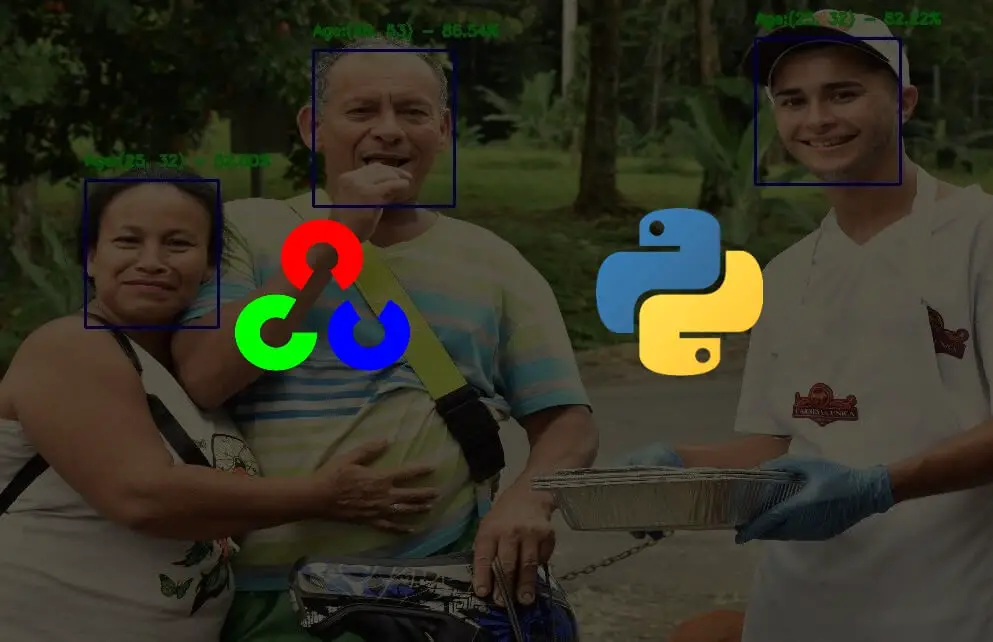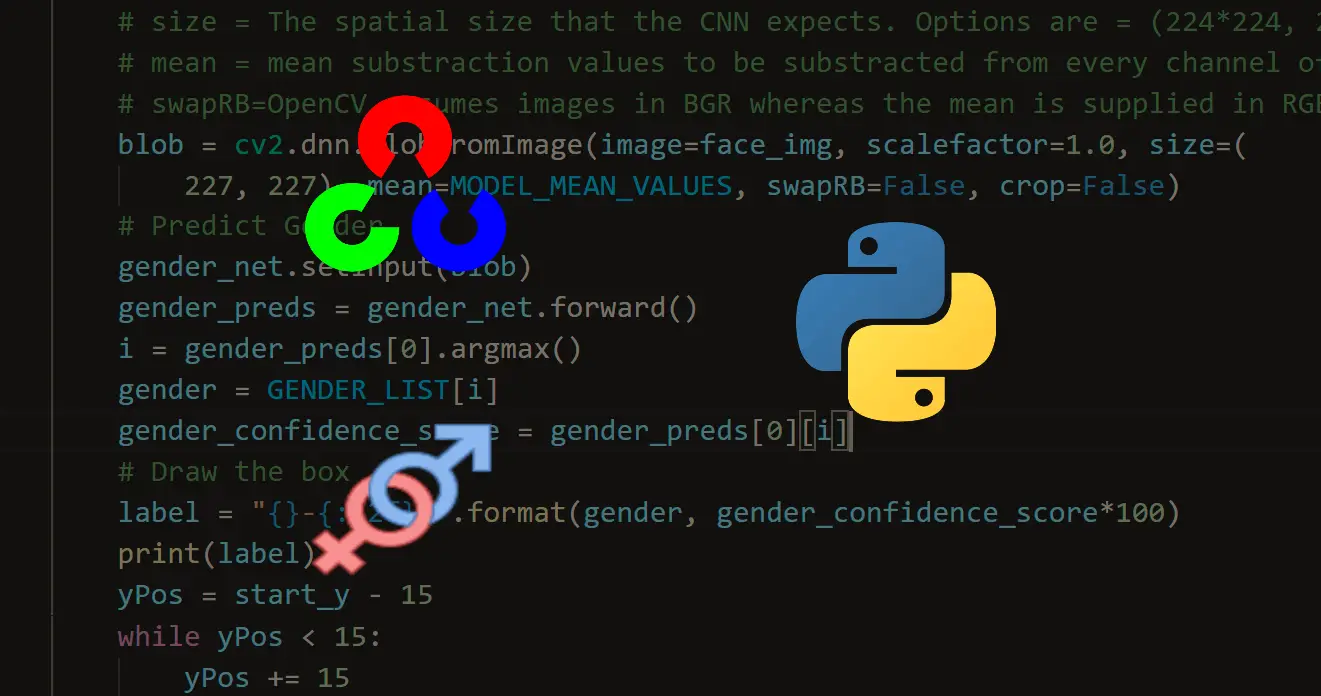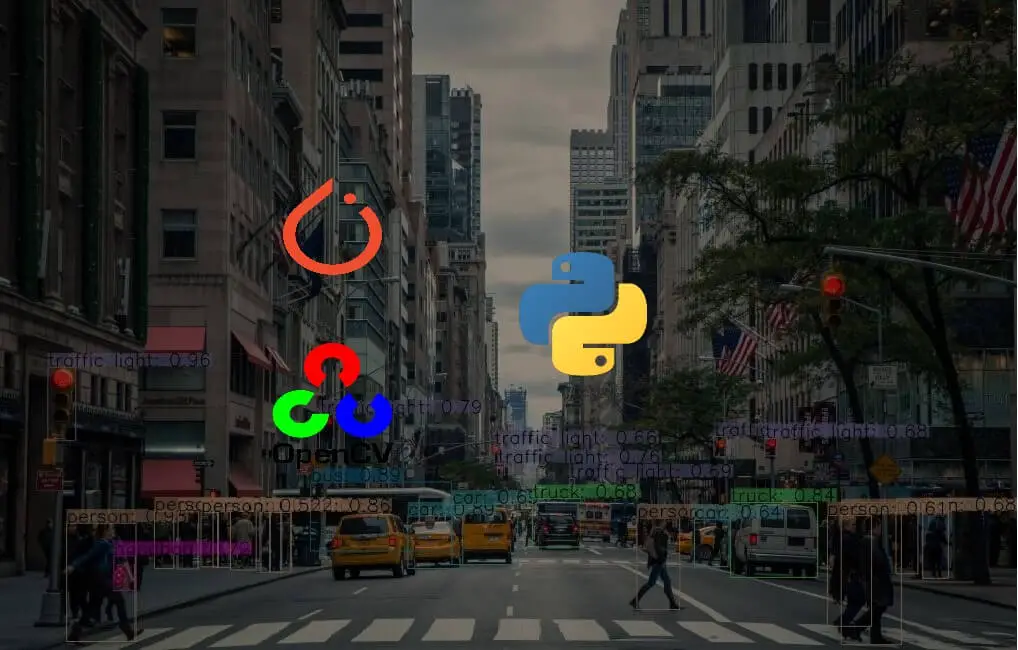Confused by complex code? Let our AI-powered Code Explainer demystify it for you. Try it out!
In this tutorial, we will combine gender detection and age detection tutorials to develop a single code that detects both.
Let's get started. If you haven't OpenCV already installed, make sure to do so:
$ pip install opencv-python numpyOpen up a new file. Importing the libraries:
# Import Libraries import cv2 import numpy as npNext, defining the variables of weights and architectures for face, age, and gender detection models:
# https://raw.githubusercontent.com/opencv/opencv/master/samples/dnn/face_detector/deploy.prototxt FACE_PROTO = "weights/deploy.prototxt.txt" # https://raw.githubusercontent.com/opencv/opencv_3rdparty/dnn_samples_face_detector_20180205_fp16/res10_300x300_ssd_iter_140000_fp16.caffemodel FACE_MODEL = "weights/res10_300x300_ssd_iter_140000_fp16.caffemodel" # The gender model architecture # https://drive.google.com/open?id=1W_moLzMlGiELyPxWiYQJ9KFaXroQ_NFQ GENDER_MODEL = 'weights/deploy_gender.prototxt' # The gender model pre-trained weights # https://drive.google.com/open?id=1AW3WduLk1haTVAxHOkVS_BEzel1WXQHP GENDER_PROTO = 'weights/gender_net.caffemodel' # Each Caffe Model impose the shape of the input image also image preprocessing is required like mean # substraction to eliminate the effect of illunination changes MODEL_MEAN_VALUES = (78.4263377603, 87.7689143744, 114.895847746) # Represent the gender classes GENDER_LIST = ['Male', 'Female'] # The model architecture # download from: https://drive.google.com/open?id=1kiusFljZc9QfcIYdU2s7xrtWHTraHwmW AGE_MODEL = 'weights/deploy_age.prototxt' # The model pre-trained weights # download from: https://drive.google.com/open?id=1kWv0AjxGSN0g31OeJa02eBGM0R_jcjIl AGE_PROTO = 'weights/age_net.caffemodel' # Represent the 8 age classes of this CNN probability layer AGE_INTERVALS = ['(0, 2)', '(4, 6)', '(8, 12)', '(15, 20)', '(25, 32)', '(38, 43)', '(48, 53)', '(60, 100)']Below are the necessary files to be included in the project directory:
gender_net.caffemodel: It is the pre-trained model weights for gender detection. You can download it here.deploy_gender.prototxt: is the model architecture for the gender detection model (a plain text file with a JSON-like structure containing all the neural network layer’s definitions). Get it here.age_net.caffemodel: It is the pre-trained model weights for age detection. You can download it here.deploy_age.prototxt: is the model architecture for the age detection model (a plain text file with a JSON-like structure containing all the neural network layer’s definitions). Get it here.res10_300x300_ssd_iter_140000_fp16.caffemodel: The pre-trained model weights for face detection, download here.deploy.prototxt.txt: This is the model architecture for the face detection model, download here.
Next, loading the models:
# Initialize frame size frame_width = 1280 frame_height = 720 # load face Caffe model face_net = cv2.dnn.readNetFromCaffe(FACE_PROTO, FACE_MODEL) # Load age prediction model age_net = cv2.dnn.readNetFromCaffe(AGE_MODEL, AGE_PROTO) # Load gender prediction model gender_net = cv2.dnn.readNetFromCaffe(GENDER_MODEL, GENDER_PROTO)Before trying to detect age and gender, we need a function to detect faces first:
def get_faces(frame, confidence_threshold=0.5): # convert the frame into a blob to be ready for NN input blob = cv2.dnn.blobFromImage(frame, 1.0, (300, 300), (104, 177.0, 123.0)) # set the image as input to the NN face_net.setInput(blob) # perform inference and get predictions output = np.squeeze(face_net.forward()) # initialize the result list faces = [] # Loop over the faces detected for i in range(output.shape[0]): confidence = output[i, 2] if confidence > confidence_threshold: box = output[i, 3:7] * \ np.array([frame.shape[1], frame.shape[0], frame.shape[1], frame.shape[0]]) # convert to integers start_x, start_y, end_x, end_y = box.astype(np.int) # widen the box a little start_x, start_y, end_x, end_y = start_x - \ 10, start_y - 10, end_x + 10, end_y + 10 start_x = 0 if start_x < 0 else start_x start_y = 0 if start_y < 0 else start_y end_x = 0 if end_x < 0 else end_x end_y = 0 if end_y < 0 else end_y # append to our list faces.append((start_x, start_y, end_x, end_y)) return facesMastering YOLO: Build an Automatic Number Plate Recognition System
Building a real-time automatic number plate recognition system using YOLO and OpenCV library in Python
Download EBookThe get_faces() function was grabbed from the face detection tutorial, so check it out if you want more information.
Below is a function for simply displaying an image:
def display_img(title, img): """Displays an image on screen and maintains the output until the user presses a key""" # Display Image on screen cv2.imshow(title, img) # Mantain output until user presses a key cv2.waitKey(0) # Destroy windows when user presses a key cv2.destroyAllWindows()Below are is a function for dynamically resizing an image, we're going to need it to resize the input images when exceeding a certain width:
# from: https://stackoverflow.com/questions/44650888/resize-an-image-without-distortion-opencv def image_resize(image, width = None, height = None, inter = cv2.INTER_AREA): # initialize the dimensions of the image to be resized and # grab the image size dim = None (h, w) = image.shape[:2] # if both the width and height are None, then return the # original image if width is None and height is None: return image # check to see if the width is None if width is None: # calculate the ratio of the height and construct the # dimensions r = height / float(h) dim = (int(w * r), height) # otherwise, the height is None else: # calculate the ratio of the width and construct the # dimensions r = width / float(w) dim = (width, int(h * r)) # resize the image return cv2.resize(image, dim, interpolation = inter)Now that everything is ready, let's define our two functions for age and gender detection:
def get_gender_predictions(face_img): blob = cv2.dnn.blobFromImage( image=face_img, scalefactor=1.0, size=(227, 227), mean=MODEL_MEAN_VALUES, swapRB=False, crop=False ) gender_net.setInput(blob) return gender_net.forward() def get_age_predictions(face_img): blob = cv2.dnn.blobFromImage( image=face_img, scalefactor=1.0, size=(227, 227), mean=MODEL_MEAN_VALUES, swapRB=False ) age_net.setInput(blob) return age_net.forward()The get_gender_predictions() and get_age_predictions() perform prediction on the gender_net and age_net models to infer the gender and age of the input image respectively.
Finally, we write our main function:
def predict_age_and_gender(input_path: str): """Predict the gender of the faces showing in the image""" # Initialize frame size # frame_width = 1280 # frame_height = 720 # Read Input Image img = cv2.imread(input_path) # resize the image, uncomment if you want to resize the image # img = cv2.resize(img, (frame_width, frame_height)) # Take a copy of the initial image and resize it frame = img.copy() if frame.shape[1] > frame_width: frame = image_resize(frame, width=frame_width) # predict the faces faces = get_faces(frame) # Loop over the faces detected # for idx, face in enumerate(faces): for i, (start_x, start_y, end_x, end_y) in enumerate(faces): face_img = frame[start_y: end_y, start_x: end_x] age_preds = get_age_predictions(face_img) gender_preds = get_gender_predictions(face_img) i = gender_preds[0].argmax() gender = GENDER_LIST[i] gender_confidence_score = gender_preds[0][i] i = age_preds[0].argmax() age = AGE_INTERVALS[i] age_confidence_score = age_preds[0][i] # Draw the box label = f"{gender}-{gender_confidence_score*100:.1f}%, {age}-{age_confidence_score*100:.1f}%" # label = "{}-{:.2f}%".format(gender, gender_confidence_score*100) print(label) yPos = start_y - 15 while yPos < 15: yPos += 15 box_color = (255, 0, 0) if gender == "Male" else (147, 20, 255) cv2.rectangle(frame, (start_x, start_y), (end_x, end_y), box_color, 2) # Label processed image font_scale = 0.54 cv2.putText(frame, label, (start_x, yPos), cv2.FONT_HERSHEY_SIMPLEX, font_scale, box_color, 2) # Display processed image display_img("Gender Estimator", frame) # uncomment if you want to save the image cv2.imwrite("output.jpg", frame) # Cleanup cv2.destroyAllWindows()The main function does the following:
- First, it reads the image using the
cv2.imread()method. - After the image is resized to the appropriate size, we use our
get_faces()function to get all the detected faces from the image. - We iterate on each detected face image and call our
get_age_predictions()andget_gender_predictions()to get the predictions. - We print the age and gender.
- We draw a rectangle surrounding the face and also put the label that contains the age and gender text along with confidence on the image.
- Finally, we show the image.
Let's call it:
if __name__ == "__main__": import sys input_path = sys.argv[1] predict_age_and_gender(input_path)Done, let's run the script now (testing on this image):
$ python age_and_gender_detection.py images/girl.jpgOutput in the console:
Male-99.1%, (4, 6)-71.9% Female-96.0%, (4, 6)-70.9%The resulting image:
 Here is another example:
Here is another example:
 Or this:
Or this:
 Awesome! If you see the text in the image is large or small, make sure to tweak the
Awesome! If you see the text in the image is large or small, make sure to tweak the font_scale floating-point variable on your image in the predict_age_and_gender() function.
For more detail on how the gender and age prediction works, I suggest you check the individual tutorials:
If you want to use your camera, I made a Python script to read images from your webcam and perform inference in real time.
Check the full code here.
Mastering YOLO: Build an Automatic Number Plate Recognition System
Building a real-time automatic number plate recognition system using YOLO and OpenCV library in Python
Download EBookHappy coding ♥
Save time and energy with our Python Code Generator. Why start from scratch when you can generate? Give it a try!
View Full Code Analyze My Code




Got a coding query or need some guidance before you comment? Check out this Python Code Assistant for expert advice and handy tips. It's like having a coding tutor right in your fingertips!